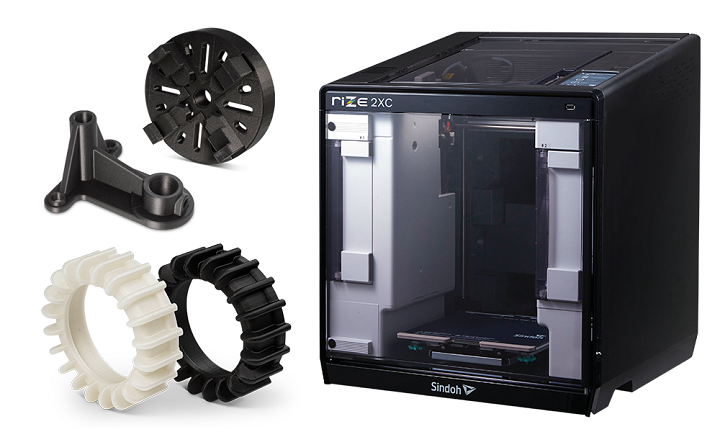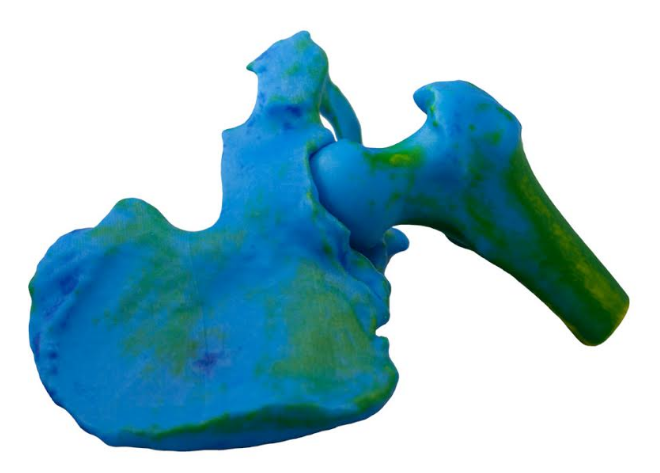Early this summer, RIZE, Inc. debuted its professional desktop RIZE 2XC, an adaptive 3D printer developed collaboratively with South Korean 3D printer manufacturer Sindoh as part of the RIZIUM Alliance that’s working to drive safer, more sustainable 3D printing. This is something RIZE takes very seriously, as RIZE President and CEO Andy Kalambi previously told me that the company’s zero-emission 3D printers are “purpose built” for safety. Now, the company has announced that the RIZE 2XC has received UL GREENGUARD Certification for safety and sustainability, which is based on the ANSI/CAN/UL 2904, “Standard Method for Testing and Assessing Particle and Chemical Emissions from 3D Printers.”
According to a study by the Georgia Institute of Technology and Chemical Insights, a Research Institute of Underwriters Laboratories (UL), emissions of volatile organic compounds (VOCs) and ultrafine particles (UFPs) from desktop 3D printers are compromising the indoor air quality for, and the health of, millions of employees, students, and patients who work near 3D printers in factories, hospitals, schools, and offices. But products that are GREENGUARD Certified, like the RIZE 2XC, have been scientifically proven to meet extremely exacting chemical emissions standards, which means they can be used indoors without causing a negative impact on the air quality, or exposing the user to harmful chemicals.
RIZE revealed in August that its industrial XRIZE printer, RIZIUM One inks, and RIZIUM ST, Carbon Fiber, and Glass Fiber composite filaments, had achieved UL GREENGUARD Certification, making it the first color, composite 3D printer to be certified for low emissions and safe usage by UL in any market, while the RIZIUM composite and inks are the first GREENGUARD-certified materials. So the RIZE 2XC is now the company’s fifth product or material to obtain this important certification, with the RIZE One being the first, and it’s also the first RIZIUM Alliance product to receive it.
I had the chance to speak with Kalambi about this exciting news, and he reiterated to me that the company’s focus has been, and will remain on, safe, affordable, and full-color 3D printing, though the 2XC itself doesn’t print in color.
“Each of these certifications have been a little different. This announcement isn’t so much about 2XC or GREENGUARD, but it’s about what we have done through material science,” Kalambi told me. “In 3D printing, there are two aspects, one is printing and one is the material science behind it.”
In addition to being the only 3D printing company this year that was selected as a Technology Pioneer for the World Economic Forum, RIZE is also the top provider of GREENGUARD-certified products in the AM industry, and Kalambi believes that it’s the only company that has announced a GREENGUARD-certified 3D printer as well.
“I think there’s a heightened concern about health and safety now, about environmental issues, and people are interested in more sustainable ways of doing production,” Kalambi continued. “We want things to be sustainable and inclusive. I’m sitting in my basement right now with the 2XC behind me, no venting needed.”
With the RIZIUM Alliance, third party FDM 3D printer makers—like Sindoh with the 2XC—work with RIZE to adapt their existing printers for use with its safer, more sustainable materials.
“Sindoh has always made user safety is a top priority, and RIZE has taken this to the next level by meeting the rigorous standards of the UL GREENGUARD program by applying RIZE’s materials and process optimization expertise in the RIZE 2XC. As a member of the RIZIUM Alliance, we are committed to innovating in materials and technologies with RIZE to allow organizations to deploy safe, affordable 3D printing anywhere and everywhere,” BB Lee, CEO, 3D Printing Division at Sindoh Co., Ltd, said in a press release.
Right before the COVID-19 crisis was declared a pandemic in March of 2020, RIZE began working with Sindoh on the 2XC, and employees then completed the entire project mostly from home. In Kalambi’s words, the team “took an existing FDM machine and through material science eliminated some big problems.”
“FDM 3D printers need venting because of VOC and UFP emissions,” he explained. “We said, ‘There’s a bigger market for FDM printers, but how do we make that environment safe?’
“How could we do it? Material science. We’re as much a material science company as a 3D printer company.”
Kalambi explained that the first step was to get rid of the typical FDM dry box, because it isn’t offering “a controlled, dry shelf life.” Then, they needed to add venting. Many printers feature a hood or a HEPA filter, but they only trap some of the harmful emissions, not all of them. The most important step was eliminating all chemicals in post-processing, such as water-soluble supports that need to be removed with chemicals.
“We want printers that are absolutely safe,” Kalambi said.
“So we said, let’s take an existing machine and see if we can do it. We were able to deliver, and got the UL GREENGUARD certification for this printer.”
 Kalambi reminded me that the “C” in the printer name stands for composite, “for the materials we use.” He explained that RIZE machines can print using common AM materials, such as nylon and ABS, but that the technology “can have its own quirks” and change the material properties during printing, “which can lead to all kinds of issues.”
Kalambi reminded me that the “C” in the printer name stands for composite, “for the materials we use.” He explained that RIZE machines can print using common AM materials, such as nylon and ABS, but that the technology “can have its own quirks” and change the material properties during printing, “which can lead to all kinds of issues.”
“So we decided to take a different approach, and engineer a material to a specific purpose,” he told me. “We took the hard route of taking a different material, which isn’t used in the industry, and compounded it so it would have zero emissions, would not absorb moisture, and have excellent properties, like strength and durability. We want durable parts, strong parts, printed absolutely safely. So with all that, we had to engineer the material.”
The last thing that RIZE needed to do with FDM printers through the RIZIUM Alliance was add color, and make sure that materials could be impregnated with its ink while being printed. Kalambi explained that its inks have to interact very gently with the material, and that it’s “more like dying, not painting.” The color won’t fade, or react to other chemicals…another example of RIZE’s excellent material science expertise.
“Our mission is making this technology truly inclusive and sustainable. So that’s really the story: the power of material science and its ability to transform the experience and really solve problems,” Kalambi concluded. “FDM technology has been around for 30 years and some of these problems have never been solved. Material science is here to help address those problems. And that’s why we call it the RIZIUM Alliance, we want to promote this as a way to really work with the industry. Most companies are very closed, and only want their printers to work with certain materials. Our previous systems with our hybrid technology were like this, but not now. We don’t need a closed approach, we’ve been able to fit our solution into a standard printer. We’re even shipping the 2XC to people’s homes now, one of our biggest customers ordered these for their employees to use at home, since people can’t go into their labs now. Our team was able to work with no interruptions, because we can bring the 2XC home safely. It really helps.”
I asked Kalambi what RIZE has planned for 2021, and he said that the company will be building on two themes, the first of which is safe, affordable colors. He showed me a 3D printed model of a human hip, and explained that the color wasn’t just to make it look nice, but that it comes from data about the body part, such as bone density. An implant like this could cost upwards of $1,000 to make using other manufacturing technologies, and that’s not even counting CT segmentation.
“We can do materials at 20% less cost,” Kalambi told me.
“We want color to be something everyone can afford. That’s one of our messages: every FDM part should be in color.”
He mentioned that next year, the company will be introducing new versions of its colors in order to enhance the fidelity and “expand the application suite past life sciences to more urban lifestyle applications.” As an example, he showed me a 3D printed piece of sushi that looked so real, I had the urge to grab a pair of chopsticks and order lunch. Even through the computer screen, I could see just how vibrant the reddish color of the “tuna” was, which was pretty impressive.
The second theme RIZE will focus on in 2021 is safe, available manufacturing.
“We want people to be able to produce anywhere they want, not necessarily in a factory or someplace that requires a lot of infrastructure,” Kalambi said. “If I want to print in my garage or basement, I should be able to do it.”
Kalambi also mentioned that, as it is a Technology Pioneer, the company is currently working with the World Economic Forum on several projects regarding new business models. We should learn more about this next month, but he did say that the focus is making 3D printing more inclusive.
“We also want to try to keep people safe as much as we can, since we’re not out of this crisis yet,” he said, bringing up the omnipresent COVID-19 pandemic. “We want people to stay safe with whatever they’re doing.”
Subscribe to Our Email Newsletter
Stay up-to-date on all the latest news from the 3D printing industry and receive information and offers from third party vendors.
Print Services
Upload your 3D Models and get them printed quickly and efficiently.
You May Also Like
U.S. Navy Lab Uses 3D Printing to Reduce Tooling Lead Time By Over 90%
The F-35 Lightning II Joint Program Office (JPO), responsible for life-cycle management of the key fifth-generation joint strike fighter (JSF) system used by the U.S., its allies, and its partners,...
Etsy Design Rule Change Reduces Selection of 3D Printed Goods
Online marketplace Etsy has implemented a rule change requiring all 3D printed goods on the site to be original designs. The update to the site’s Creativity Standards states, ¨Items produced using...
Honeywell Qualifies 6K Additive’s Nickel 718 for 3D Printed Aerospace & Defense Parts
6K Additive is renowned for manufacturing sustainable additive manufacturing (AM) powder, and offers a wide portfolio of premium metal and alloy powders that include titanium, copper, stainless steel, and nickel,...
MetalWorm Sells WAAM Systems to Research Institutes in Brazil and Malaysia
Turkish WAAM firm MetalWorm has sold a system in Malaysia and another in Brazil. This is an excellent example of a few emerging trends in additive. Firstly, WAAM was experimented...




































